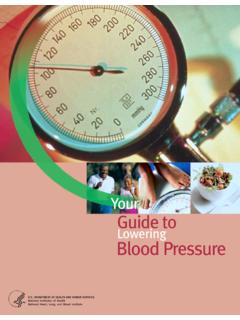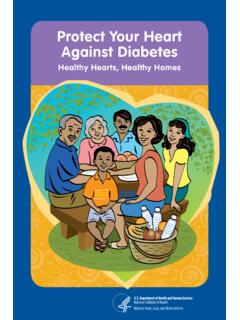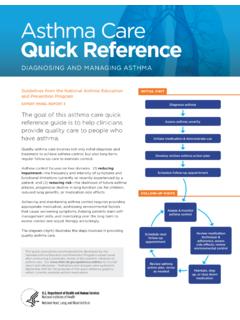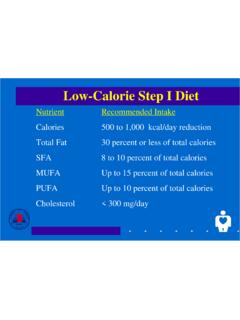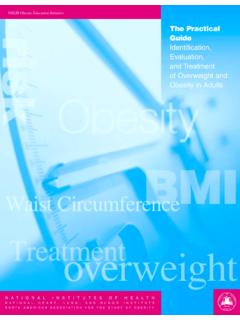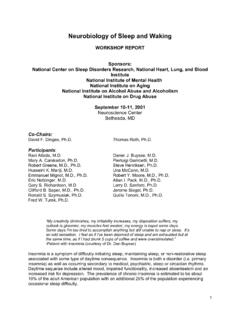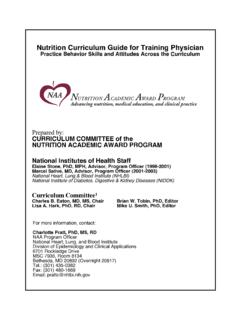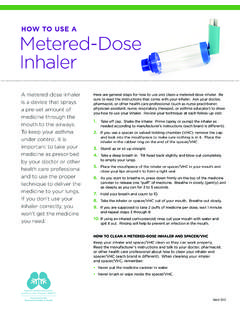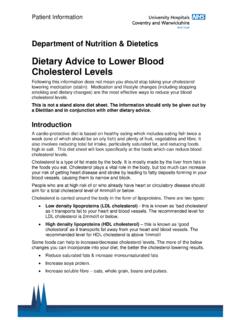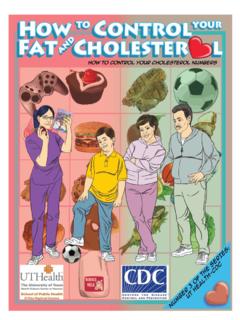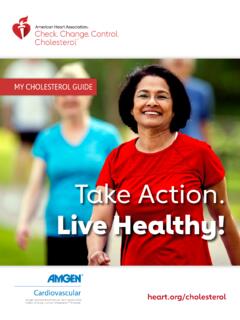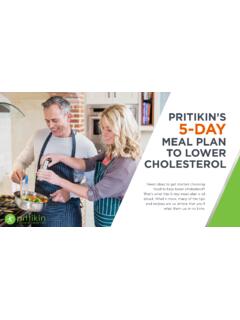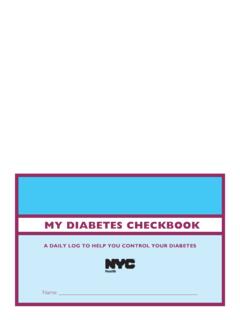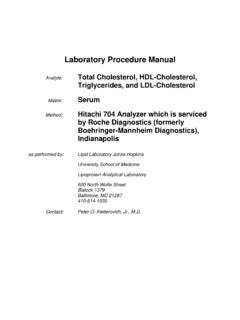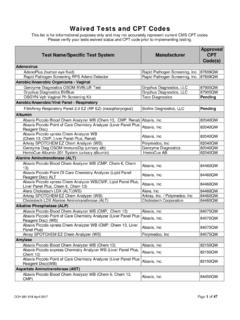Transcription of Risk Assessment - Advancing Heart, Lung, Blood, and Sleep ...
1 Assessing Cardiovascular Risk Systematic Evidence Review From the Risk Assessment Work Group, 2013 ASSESSING CARDIOVASCULAR RISK: SYSTEMATIC EVIDENCE REVIEW FROM THE RISK Assessment WORK GROUP, 2013 i Contents v Risk Assessment Work Group .. vi Section 1: Background and Description of the NHLBI Cardiovascular Risk Reduction Project .. 1 Background .. 1 Overview of the Evidence-Based Methodology .. 2 i. System for Grading the Body of Evidence .. 3 ii. Peer-Review Process .. 4 iii. Critical Question-Based Approach .. 4 Charge to the Risk Assessment Work Group .. 4 Considerations in Developing the Approach to Risk Assessment .. 5 Methods for Modeling Risk and Developing Algorithms .. 6 Development of ASCVD Risk Equations .. 10 i.
2 Internal Validation .. 16 ii. External Validation .. 17 iii. Limitations .. 21 Implications for Risk Assessment .. 21 Section 2. Critical 44 A. CQ1 .. 44 i. Selection of the I/E Criteria .. 44 ii. Rationale for Selecting This CQ and I/E Criteria and Identifying Them as a Priority .. 45 iii. Methods for CQ1 .. 45 iv. Evidence Summaries .. 46 B. CQ2 .. 50 i. Selection of the I/E Criteria .. 51 ii. Rationale for Selecting This CQ and I/E Criteria and Identifying Them as a Priority .. 51 iii. Methods for CQ2 .. 53 iv. Evidence Summaries .. 53 v. Evidence Statements for CQ2 .. 53 Section 3. Abbreviations and Acronyms .. 59 Appendixes Appendix A. Detailed Methods Applying to All Critical Questions .. A 1 Appendix B. Question-Specific Methods.
3 B 1 References .. R 1 ii ASSESSING CARDIOVASCULAR RISK: SYSTEMATIC EVIDENCE REVIEW FROM THE RISK Assessment WORK GROUP, 2013 List of Tables Table 1a. Characteristics of Previously Published Risk Scores and Current NHLBI Pooled Cohort Risk Scores, Including Data Sources and Covariates .. 7 Table 1b. Characteristics of Previously Published Risk Scores and Current NHLBI Pooled Cohort Risk Scores, Including Data Sources and Outcomes .. 8 Table 2a. Baseline Characteristics (Unadjusted) of the Risk Estimation Population of Women by Study Cohort and Race (Age Criterion 40 to 79) .. 11 Table 2b. Baseline Characteristics (Unadjusted) of the Risk Estimation Population of Men by Study Cohort and Race (Age Criterion 40 to 79) .. 12 Table 3.
4 Considerations for Evaluating New Risk Factors When Assessing Clinical Utility for Risk Assessment (Derived From Hlatky 200941) .. 13 Table 4a. Example of Estimation of 10-Year Risk for Hard ASCVD, Defined as Occurrence of Coronary Death or Fatal Stroke or First Occurrence of Nonfatal MI or Stroke; Equation Parameters and Specific Example for Women of Each Race .. 14 Table 4b. Example of Estimation of 10-Year Risk for Hard ASCVD, Defined as Occurrence of Coronary Death or Fatal Stroke or First Occurrence of Nonfatal MI or Stroke; Equation Parameters and Specific Example for Men of Each Race .. 15 Table 5. Estimating an Individual s 10-Year Risk for Incident Hard ASCVD .. 16 Table 6a. Summary of Internal Validation of Risk Prediction of Hard ASCVD and the Components of ASCVD Within 10 Years Using a 10x10 Cross-Validation for People Classified as White.
5 17 Table 6b. Summary of Internal Validation of Risk Prediction of Hard ASCVD and the Components of ASCVD Within 10 Years Using a 10x10 Cross-Validation for People Classified as African American .. 17 Table 7a. Number of Events, C-Statistic, and Calibration Chi-Squared Statistic of the Combined Studies Hard CVD Risk Prediction Equation as Applied to the Validation Cohorts of a Contemporary Cohort Studies Population, MESA and REGARDS Studies for People Classified as White .. 18 Table 7b. Number of Events, C-Statistic, and Calibration Chi-Squared Statistic of the Combined Studies Hard CVD Risk Prediction Equation as Applied to the Validation Cohorts of a Contemporary Cohort Studies Population, MESA and REGARDS Studies for People Classified as African American.
6 19 Table 8a. Predicted Probability of Incident ASCVD Within 10 Years by Specific Combinations of Total cholesterol , HDL- cholesterol , Systolic blood Pressure and Current Smoking for Non-Hispanic African American Women Without Diabetes .. 23 Table 8b. Predicted Probability of Incident ASCVD Within 10 Years by Specific Combinations of Total cholesterol , HDL- cholesterol , Systolic blood Pressure and Current Smoking for Non-Hispanic African American Women With Diabetes .. 25 Table 9a. Predicted Probability of Incident ASCVD Within 10 Years by Specific Combinations of Total cholesterol , HDL- cholesterol , Systolic blood Pressure and Current Smoking for Non-Hispanic White Women Without Diabetes .. 27 Table 9b. Predicted Probability of Incident ASCVD Within 10 Years by Specific Combinations of Total cholesterol , HDL- cholesterol , Systolic blood Pressure and Current Smoking for Non-Hispanic White Women With Diabetes.
7 29 ASSESSING CARDIOVASCULAR RISK: SYSTEMATIC EVIDENCE REVIEW FROM THE RISK Assessment WORK GROUP, 2013 iii Table 10a. Predicted Probability of Incident ASCVD Within 10 Years by Specific Combinations of Total cholesterol , HDL- cholesterol , Systolic blood Pressure and Current Smoking for Non-Hispanic African American Men Without Diabetes .. 31 Table 10b. Predicted Probability of Incident ASCVD Within 10 Years by Specific Combinations of Total cholesterol , HDL- cholesterol , Systolic blood Pressure and Current Smoking for Non-Hispanic African American Men With Diabetes .. 33 Table 11a. Predicted Probability of Incident ASCVD Within 10 Years by Specific Combinations of Total cholesterol , HDL- cholesterol , Systolic blood Pressure and Current Smoking for Non-Hispanic White Men Without Diabetes.
8 35 Table 11b. Predicted Probability of Incident ASCVD Within 10 Years by Specific Combinations of Total cholesterol , HDL- cholesterol , Systolic blood Pressure and Current Smoking for Non-Hispanic White Men With 37 Table 12. Distribution of 10-Year Risk for Hard ASCVD in the CVD-Free, Nonpregnant Population Ages 40 to 79 (NHANES 2007 2010), by Sex and Race (N=5,367, Weighted to 100,542,000 Population) .. 40 Table 13. Distribution of 10-Year Risk for Hard ASCVD in the CVD-Free, Nonpregnant Population Ages 40 to 79 (NHANES 2007 2010), Stratified by Age and Sex Groups (N=5,367, Weighted to 100,542,000 Population) .. 41 Table 14a. Distribution of 10-Year Risk for Hard CHD (Per ATP III Risk Equation) vs. 10-Year Risk for Hard ASCVD (Per NHLBI Risk Equations) in the Total CVD-Free, Nonpregnant Population Ages 40 to 79 (NHANES 2007 2010).
9 42 Table 14b. Distribution of 10-Year Risk for Hard CHD (Per ATP III Risk Equation) vs. 10-Year Risk for Hard ASCVD (Per NHLBI Risk Equations) in the CVD-Free, Male Population Ages 40 to 79 (NHANES 2007 2010) .. 42 Table 14c. Distribution of 10-Year Risk for Hard CHD (Per ATP III Risk Equation) vs. 10-Year Risk for Hard ASCVD(Per NHLBI Risk Equations) in the CVD-Free, Nonpregnant Female Population Ages 40 to 79 (NHANES 2007 2010).. 43 Table A 1. Quality Assessment Tool for Controlled Intervention Studies .. A 6 Table A 2. Quality Assessment Tool for Systematic Reviews and Meta-Analyses .. A 10 Table A 3. Quality Assessment Tool for Observational Cohort and Cross-Sectional Studies .. A 13 Table A 4. Quality Assessment Tool for Case-Control Studies.
10 A 20 Table A 5. Evidence Quality Grading System .. A 28 Table B 1. Risk Assessment Work Group CriticalQuestion1 PICOTSS .. B 6 Table B 2. Risk Assessment Work Group Critical Question1 Inclusion/Exclusion Criteria .. B 7 Table B 3. Risk Assessment Work Group Critical Question 1 Systematic Reviews Evidence Conclusions .. B 8 Table B 4. Risk Assessment Work Group Critical Question 2 PICOTSS .. B 11 Table B 5. Risk Assessment Work Group Critical Question 2 Inclusion/Exclusion Criteria .. B 12 Table B 6. Risk Assessment Work Group Critical Question 2 Summary Table .. B 13 iv ASSESSING CARDIOVASCULAR RISK: SYSTEMATIC EVIDENCE REVIEW FROM THE RISK Assessment WORK GROUP, 2013 List of Figures Figure 1. Kaplan-Meier Observed Event Rate and Predicted Event Rate for the ASCVD Outcome in the External Validation Samples From the Most Contemporary Cohort Studies Dataset, MESA, and REGARDS, by Race, Sex, and Selected Predicted Risk Groupings.
